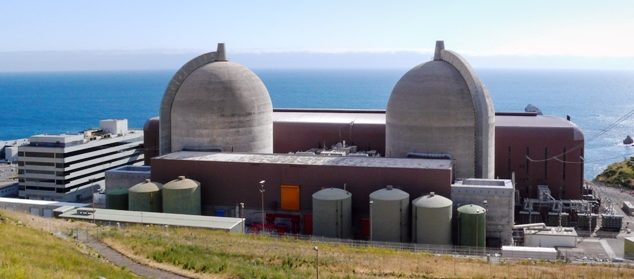Opinion
Closing Diablo Canyon spurs fears over replacement power
 The Diablo Canyon nuclear power station on the coast of Central California. (Photo: Tracey Adams, via Wikipedia and Flickr)
The Diablo Canyon nuclear power station on the coast of Central California. (Photo: Tracey Adams, via Wikipedia and Flickr)California’s power is expensive and polluting – but doesn’t have to be.
The state of California plans to replace Diablo Canyon Power Plant (DCPP) mostly with Wyoming coal-fired generation. The source of the replacement power will remain hidden until 2025, when Californians can’t stop the state.
As a nonprofit intervenor before the California Public Utilities Commission (CPUC) since 2016, Californians for Green Nuclear Power (CGNP) has uncovered four obscure clues in CPUC filings that confirm the state’s plan. CGNP’s thousands of pages of filings provide the details.
While Diablo Canyon is compact, it’s annual production is the equivalent of five Hoover Dams.
The first clue is the engineering requirement that since Diablo Canyon Nuclear Power Plant is a reliable 24/7 generator, any incremental replacement generation must have similar reliability. Otherwise, rolling blackouts occur.
Engineers use the term “dispatchable” (under human control) to describe Diablo Canyon’s power. Dispatchable generators that supply power like Diablo Canyon are powered by natural gas or coal. The ongoing drought means building new dams is impractical. While Diablo Canyon is compact, it’s annual production is the equivalent of five Hoover Dams.
Californians demand that California’s coal plants be shut down and they object to new plants powered by natural gas.
Widely-promoted solar and wind aren’t dispatchable. The sun doesn’t always shine and the wind doesn’t always blow with sufficient force. Natural gas fills in for solar and wind’s substantial intermittencies. Batteries are extremely expensive — and could optimally be reserved for vehicles to improve air quality, instead of displacing natural gas in power plants.
Those constraints imply that California’s replacement generation must be located mostly out of state. There are many generators that could produce additional power to replace Diablo Canyon located in or near the nation’s biggest coal deposits in Wyoming.
“Unspecified imports” sounds nicer than coal. Unfortunately, this term mostly applies to out-of-state coal power.
The second clue is the requirement that a new transmission network needs to be built to send the power about 1,000 miles from Wyoming to California.
Such a large network, first announced in 2007, is the Energy Gateway. The network’s mastermind, Warren Buffett, stated in his 2021 letter to shareholders the network would cost $18 billion by 2030. Oregon and Washington state have already announced upcoming bans against out-of-state coal power. Thus, by California utility law, most of this transmission cost will be borne by Californians.
Third clue: A California legal euphemism “unspecified imports,” which sounds nicer than coal, was created in 2009. Unfortunately, this term mostly applies to out-of-state coal power.
The term appears twice on page 16 in the CPUC’s June 24, 2021 procurement decision in R2005003. Between 4,000 and 5,000 megawatts (MW) of generation capacity is stipulated,. In order to convert this to more familiar kilowatt-hours (kWh) on your power bill, the capacity factor, or percentage ON time is used. California nuclear power has a capacity factor of 90% and there are 8,766 hours in a year. The product of 5,000 MW times 8,766 hours times 90% is 40 billion kWh.
The fourth clue is the increased air pollution from burning coal.
How can California’s leaders evade this problem? The answer requires models they can manipulate. On page 104 of the CPUC’s R2005003 Preferred System Portfolio adopted on Feb. 10, 2022 is the sentence, “Criteria pollutants were counted from generation within California only, and not from unspecified imports.” This means toxic air pollution from out-of-state coal power is artificially zeroed.
The increased demand for U.S. natural gas to supply Europe after Russia’s invasion of Ukraine means increased gas costs for utilities, resulting in pressure to burn more coal. Since nuclear plants like Diablo Canyon don’t emit air pollution, they should remain online instead.
With the increased transmission costs, in 2025 Californians could have the worst of both worlds with significantly higher toxic pollution released into the environment — while paying more for this emission-laden power from Wyoming.
Beginning to reverse California’s harmful energy policies means continuing operation of safe, reliable and cost-effective zero-emission Diablo Canyon well beyond 2025.
—
Ed’s Note: Gene Nelson has a Ph.D. in radiation biophysics and served as a science and engineering professor at 3 colleges and a university. He helped found CGNP in 2013, and has been CGNP’s Legal Assistant since 2016.
Want to see more stories like this? Sign up for The Roundup, the free daily newsletter about California politics from the editors of Capitol Weekly. Stay up to date on the news you need to know.
Sign up below, then look for a confirmation email in your inbox.

Leave a Reply